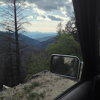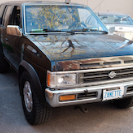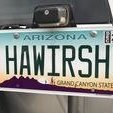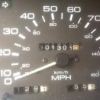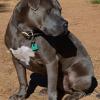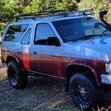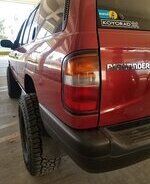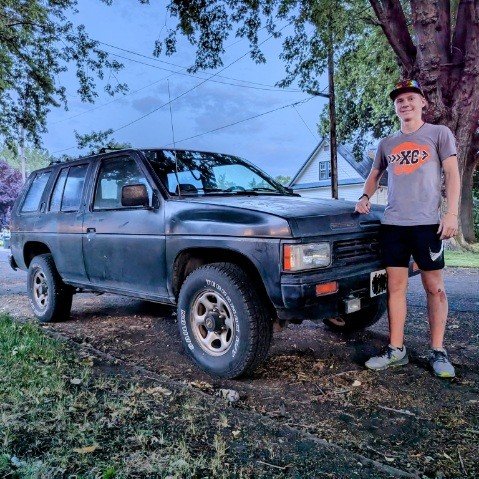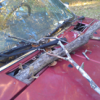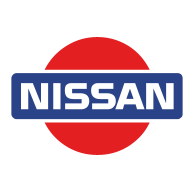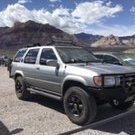- Sign In Changes: You now need to sign in using the email address associated with your account, combined with your current password. Using your display name and password is no longer supported.
- If you are currently trying to register, are not receiving the validation email, and are using an Outlook, Hotmail or Yahoo domain email address, please change your email address to something other than those (or temporary email providers). These domains are known to have problems delivering emails from the community.
Leaderboard
Popular Content
Showing content with the highest reputation since 01/21/2025 in all areas
-
Items in the works: I've got a handful of things still to do short term but the list is finally getting shorter. Firstly the important items learned from the recent Moab trip would be that I need axle limiting straps and a taller spring would be ideal. I want to eliminate the HDPE spacers I've used for years and get an all-spring setup. I may also move the spring perches forward and fabricate new lower shock mounts that will provide more clearance. Still have some research to do on that front. While I was coming through Oregon I took advantage of a sale+no tax+IST coupon to walk out the door with a 12K winch for $260 bucks. Just need to swap over my old 9.5K Smittybilt synthetic rope and figure out where to remote mount the solenoid. The front suspension really isn't terrible, especially given my KYB's are approaching 10 years of age, but my roots in high speed off-road really have me wanting to build a better front end. Long term I have plans to make a LT front setup that should fit the bill very nicely but it'll be a ways off. For now there are a set of motorsport coilover struts that should work with the Nissan suspension components after a few changes. I think the weakest link of the whole front setup is the lower control arm mounts and overall method of stamped sheet metal manufacturing. A set of chromoly tube arms with through-bolt mounts and the motorsport coilover struts would be pretty slick and get me closer to the machine I want. I'm sure there are a few bits I've missed but this should be mostly up to date now. A few pics from the recent Moab trip with @hawairish7 points
-
Forum has been restored and secured for now. Further safeguards will be put in place soon. In the coming weeks software updates will also take place. An exact timeline has not yet been determined, but some of this work may result in the forum being offline temporarily.5 points
-
I have not yet been given an actual cause for this nearly week long outage, but after spending hours on the phone with the host company today, repeatedly reminding them that they had assured the site would be back up before this past weekend, here we are back up and running... finally! edit: Turns out the host utilizes AWS facilities, so this was related to the major AWS outage that occurred at the same time. Don't know why they couldn't just say that from the beginning.4 points
-
Falling behind on updates again... My guys' trip to Moab has come and gone, but unfortunately the truck was not ready in time for it. I still made it up there and had a great trip riding shotgun in Towndawg's truck (recently fitted with 4:1 t-case gears and a rear ARB locker...front ARB didn't get installed in time). Long story short, I was able to get the truck out of the garage and around the block a few times, but the steering and alignment didn't feel right, and the gear box started leaking. I had already rebuilt the power steering lines again (they had sprung a leak a 2nd time) so I have little confidence in their ability at the moment, but they seem to be holding now. This time around I snugged the fittings up a little less thinking maybe I was over-tightening them and compromising the liner. But frankly, if they're this sensitive to assembly, I probably don't want them. For now, they'll do. Parts are on order to rebuild the gear box, which I probably should have done in the first place. Beyond that, the setup has not been tested at all...but at least it drives now! Here were the finishing pieces of the build... The driveshaft adapter turned out great: Got the new rear 5.13 (41:8 = 5.125) gears installed. That took a lot of effort, though. I've surely mentioned it before, but the H233 used thick rings/spacers/washers of different thicknesses to set pinion height and preload, and practically all of those pieces are either no longer available, or several bucks each (and you don't really know which piece you'd need unless you have the proper setup tools). It didn't use traditional shims, and even then, there aren't really any good options available due to odd metric sizes. Fortunately, the new pinion gear sat high, so I was able to grind down OE spacer pieces on a flat belt sander. Unfortunately, it was a lot of trial-and-error to dial in the height (a lot of pressing pieces on and pulling pieces off), and I basically took the pieces down to the minimum factory dimensions to get it as close as I could. It sucked and took a lot of time, but the pattern is good. I also managed to strip some threads on the bracket that holds the actuator piston for my TJM, so I had to pull that off to weld some nuts on get some threads. I got the switches wired up for the overhead console the other week. I ran some 8-conductor wiring up the passenger A-pillar and into the engine bay. Six of the wires are for the overhead panel, and the other 2 I'll wire up for powering a USB port for the dash cam eventually. I ended up drawing ACC power, ground, and illumination from the compass module. Opened it up, soldered on leads, and crimped on terminals and harnesses. The panel is for a Patrol, and while the color isn't a perfect match for my gray "K" trim, it's close enough for me and I'm super happy to finally put it to use. Things are wired up in a way that's consistent with their usage; i.e., you can't engage the front locker unless the rear locker is engaged, and you can't engage the sway bar disconnect or rear locker until the compressor is on. Remote Air is for the tire inflation setup; it can either hold the air, deflate, or inflate. I was not able to get the compressor, relays, or solenoids wired up until last night, and tonight I needed to sort out some leaks from having to shuffle around my setup. These are not the finished pics, but close enough for now. I opted to use some modular solenoids that stack together instead of the ARB style solenoids...that 4-solenoid modular unit costs less than one ARB solenoid, but was a little tough to find. That funky rubber boot thing is an adjustable pressure sensor switch that I was hoping to use for the tire inflation (Remote Air) switch, so that it would stop inflating at a set PSI. Unfortunately, it's so sensitive that it'll just flutter at the set temperature and cause the compressor to keep cycling. So, I'll probably just retain it as a safety cut-off. Also determined tonight that gauge is garbage...it's way off. Lastly, this is how it sat as of yesterday before a powerwash. I spy something SASsy.4 points
-
3 points
-
3 points
-
I just stumbled across some info on the 190F thermostat. It does exist, but Nissan warns of cats and dogs living together if it's used in a VG. The problem with the 190F thermostat is that the VG does not run at the temperature of its thermostat. The VG's thermostat is located on the lower rad hose, the cold end of the system, so the engine actually runs 10-15C hotter than its thermostat. Nissan's target for max engine temp is 90C (194F). 76.5C (170F) plus 15C is right on target at 91C. 82C (180F) plus 15C is pushing it at 97C, but apparently Nissan was comfortable with this, because NTB94-020 recommends swapping in a 180F thermostat to help the heater keep up with winters on Hoth (like Adam did), and (as Adam noted) they later spec'd 180F thermostats for the VG33E. 88C (190F) plus 15C is 103C, and apparently that's out of Nissan's comfort zone, because they warn that it could cause overheating, detonation, engine damage, computer trouble, and a voided warranty. The 190 thermostat was used in earlier (pre-VG) Nissan engines. They had the same 90C/194F max temp target, but their thermostats were on the upper rad hose, so they didn't have that 10-15C offset to factor in. TL;DR: 170 is stock, 180 is OK, and 190 is not recommended.3 points
-
Changed out the front axle shafts for the Trakmotive extended travel units. Much beefier than OE and they come with the Thermoplastic boots. That said- they skimp on paint or any kid of coating so they rust quickly. I suggest immediately painting them if you get a set.3 points
-
The rear arms I built years ago got an axle side change to some beefy heims in recent years. I'll start by saying I don't recommend them and will be changing them to Johnny Joints in the near future. They are super high maintenance and started squeaking within a year of install. They're probably fine for a trail toy or someone who just doesn't care about the noise. The performance was impressive but not worth it in the end. I started by media blasting the arms I built to get rid of the damage from DOT liquid de-icer's used in recent years. Then painted everything and applied a healthy layer of anti-seize. I kept the body-side rod ends poly to provide some insulation from noise and vibration and the combo worked well prior to the heims making noise. At this time I made a driveshaft spacer from 6061 AL to allow me to push my axle further back into the center of the wheel arch. Pretty easy job and solved an issue with lifted R50's that most folks don't account for when going higher. At some point during all this I started rehabbing a spare HB233 housing for the eventual rear disc brake setup that I picked up from @hawairish. I had the axle housing media blasted and coated it in POR-15. My OE axle shafts needed to be turned down to fit the WD rotors but later models apparently don't need that modification as the axle flanges were smaller in diameter. All new seals, bearings, rotors, pads and refreshed calipers. When I eventually get the axle done it'll be a short period of down time since I should have everything ready to swap in.3 points
-
I said goodbye to my old set of KM2's on vintage mags and K02's on Tacoma alloys. Picked up a new full set, including a matching spare, of KM3's on some 15x10 AR alloys. With the impending long distance road trip the 8 year old rubber was a liability and it was time for a refresh. While I was at it I installed a set of OEM Nissan manual hubs that @hawairish sent my way. Much nicer kit than the Warn units I was running and they only need a 1/4 turn to engage. Gave the refurbished bumpers a quick coat of rattle can black to clean up the truck and get ready for the Southwest trip. I installed some universal mud flaps since the OE units wouldn't clear the tires to complete the look and so far they've held up really well. They come without brackets or mounting holes so it left a lot of room for interpretation but overall I think they're a great solution for my needs.3 points
-
The entire cooling and belt drive system was refreshed. New radiator, pump, thermostat and housing, hoses, belts, power steering pump, alt, idlers, fan bearing bracket, fan and clutch. During my repairs I've been finding that many components, brackets, bolts etc...they're all succumbing to rust. I started ordering full sets of all bolt and nut sizes/pitches of yellow zinc JIS hardware to have on hand as I go through my truck and other projects. Additionally, i found that electrolysis is a great way to clean up super rusty parts prior to painting.3 points
-
The universal sliders I've been holding onto for as long as I've lived here finally got mounted. Again, thanks to the brilliant engineering that @hawairish cooked up I mounted them via the OE locations using a set of QX4 step rail brackets and the adapter plates that he generously designed and cut out at his lab. They're robust, can easily support the weight of the truck and completely bolt-on. The truck also got a complete set of 2nd hand Coastal bumpers with a swing out that was conveniently located locally. The kit was professionally welded at a SoCal race shop so the fit up and quality was superb. Just needed a respray and some minor cosmetic repair. I bought the correct color matched silver to paint them but the window to paint outdoors here is very short and i have not managed to get the time in the 3 years since owning this set. I wasn't much of a fan of the Coastal options so I shaved most of what was on the bumper with the intention of 3D printing my own AUX/Fog light housings when the time comes around to painting them. For now its just clean and simple. An element of the Coastal design that seems pretty wild to me is the disregard for the power steering cooling line. These trucks use an aluminum tube that runs directly across the lower radiator support that the coast kit neglects, forcing users to bend it up out of the way. I opted to run a remote oil cooler next to my trans cooler and avoid what could be a disaster on the trail from a bump or collision.3 points
-
The truck now has 4.6 gears. Initially I installed a SuperPacked LSD rated at 236.5 ft/lbs of breakaway that @hawairish built but after driving it for a while I found it wasn't really appropriate for my intended uses and the wet PNW environment. Would be great for a trail toy or sport truck application. So I ended up going with ARB lockers front and rear. The front hasn't made it into the truck yet but is on the bench as the next major item. The truck is already plumbed for it so I just need to finish the install into the housing and stuff it under the truck. @hawairish hooked it up with a slick bracket that he cooked up for mounting my old ARB single in the engine bay. I had originally mounted it in the rear passenger cubby and it worked well for the last 10 years in that location serving the sole purpose of inflating my tires after trail runs but with the ARB's it was time to relocate. I installed the switch panel that @hawairish and I ordered a while back that replaces the sunglass holder to run everything- Compressor, front and rear lockers, light bar, trail lights and AUX backup lights. Super stoked with the result.3 points
-
Long time with no update! The truck is back from a recent trip to Moab with @hawairish and his build has inspired me to bring this thread up to speed... The truck has seen lots of trips and a handful of upgrades. Most notably is the rebuilt trans. Had some water intrusion in 2024 that prompted me to have it professionally rebuilt with a couple minor upgrades for durability and longevity. I paired that with a set of low-range gears for the transfer case that @hawairish helped make happen. Legend has it these gears are made by the same group that manufactures OEM gears but I have no proof so take that with a grain of salt. They are manufactured in Japan and have proven themselves in Moab but the install had a few hiccups that leave me curious how others have done this DIY in a garage setting. The large 4WD shaft required machining to match the OEM length otherwise it binds on the case. Not a problem as I chucked it in the lathe and made the needed modifications but unless you can machine the case or the shaft I would say this would be a show stopper. I drilled and tapped the output shaft so that I can run a SYE in the future while I had the case apart then reassembled everything and delivered it to the shop performing the rebuild so they could install everything and get the truck back up.3 points
-
When I helped a friend swap the trans in his S10 Blazer, we just shot a spot of paint on each torsion bar adjuster. We used a different color on either side so we couldn't mix up the parts. Then when we put it back together, we just lined up the paint marks. Worked great.3 points
-
When removing your torsion bar X-member, measure the tail of the adjuster bolts , that way you can get your suspension pretty much where it was in height, then you only need a small fine tune if necessary.3 points
-
Not tearing the carpet is an incredible feat! I've definitely pulled the manual trans out of my 93 without cutting/removing the Y-pipe, but I did have the torsion bar crossmember and front diff out. Was a bit of a puzzle to get the transfer case tail housing down past the fixed crossmember, but it is doable. Front diff is very annoying to get back in because of the weird balance, but torsion bars and crossmember are pretty easy, even if a few rusted bolts give out (as they did for me). For posterity's sake, pulling the Y-pipe down off the manifolds early is very nice. With that and the trans mount disconnected, the motor mounts allow quite a bit of forward/backward tilt which can make reaching those top bell housing bolts easier. For install, I found it handy to cut the heads off a couple of spare bell housing bolts and thread them into the block. Definitely not necessary but helped a bit with aligning trans and engine. Also, since the engine can move so much it can be hard to eyeball the alignment. Having someone to watch from a wheel well while you wiggle and push is very nice. Not sure if any of this is helpful at all, but good luck!3 points
-
When I bought my 92', it had many issues. One of which was one of the rear disk rotors was ground down, for whatever reason, halfway through the rotor material on one side. I didn't think much of it until the calipers seized. I rebuilt them using brake fluid as the lubricant to reassemble them. That's what I was taught years ago, and I have been doing it ever since. Every 2 years or so, for the past 10 years, I have been tearing apart the rear calipers, unseizing the piston, cleaning the rust out and reassembling using the same process of using brake fluid to lubricate the assembly process.... When the calipers were seizing, the symptoms were pretty obvious sometimes. A smoking rotor is one of them.... One of the things that threw me off a couple of times that I didn't really put 2 and 2 together on for years, was that the ABS light would occasionally light up and stay lit when the calipers were starting to seize, and would go away for a while after the rebuild. I was making an assumption that it's old electronics and mechanical gizmos that are starting to fail. The last time I tore apart the calipers, I reassembled them around the dust boot with a one-time-use packet of synthetic brake caliper grease as recommended by one of my co-workers. I'm not entirely positive that is it's the intended use for it, but it's what I used. Ever since then, the calipers have been working flawlessly and the ABS light no longer lights past the initial POST (Power on Self Test). What I think was happening is that the Mechanical gizmo on the frame was throwing a fault when it couldn't push fluid. So... With this observation, maybe that ABS light you have on your dash being lit isn't a symptom of your module or gizmo starting to fail. Maybe it's a symptom to something else.... in my case at least. Just thought I would share one of my experiences that I learned over more than a hot minute....3 points
-
Well, this weekend was very productive. Wasn't able to roll it out, but we're getting close. Last update I mentioned the axle was being done. It's officially done and back on the truck. The bulk of the weekend was getting the axle back under the truck and slowly completing the final assembly. Right now, everything's torqued down and ready to go. Axle's centered, thing's aligned as best as I can get them with my eyechrometers. Got it to the point where the truck is resting on the axle, and tires were slapped on for a while. Still needed to tweak the steering stabilizer a bit. I finished up the mount v3 today and it's finally in a position where I don't think it's going to contact anything. Also figured I'd work on the center caps while some parts baked (powder coating). Limit straps, driveshaft adapter, and custom brake lines delivering tomorrow, among other small goodies. Been waiting on the brake lines to start the ring and pinion swap in the rear, so hopefully I get started on that mid-week.3 points
-
I've done 15,000km on my reconditioned transmission using ATF dex III and had no issues. The gent who recommended it has been building these gearboxes for decades. I dismissed this at first and put 80w90 in it, then 75W/90, and couldn't select gears when cold. Now it shifts great.3 points
-
I've heard of people jacking up one side/parking on a slope so the fill hole is higher. Might be worth a shot.3 points
-
Time to necro this post. Found the source of the rattle... loose springs on the clutch disc. I guess at low rpm they would rattle around in there until about 2k. New clutch is in and no more rattle!!!3 points
-
Today had enough progress that it deserved its own comment. After spending a couple weeks designing a few ideas that gave me some adjustability, decided the other day to just get on with it and make a static mount in what I seemed like the right spot. Pretty straight-forward at this point. This is the first mock-up with a tire...finally! There's so much space in there, that it makes the 2.0 coilovers seem puny. But hey, no more farting around with the stupid coil bucket on the McPherson strut! There's about 4" of space between the springs and tires, and about 2-3" from the inner fender. The first two pics in this post show a different attachment method, but this will be the end result. There will be a strut 'ring' atop the strut tower with bolts welded in, then the coilover mount attaches from underneath. This way I won't need to remove all the crap above the strut towers to change anything. After getting the mounts all welded up, I decided to see if the spring selection was the right one. So, time to see if it can support itself! Ride height compression... And so, I have coilover mounts! Right now this is about 1.5" taller than I predicted. I'll eventually put a bumper and winch on to pull things down another 0.75" or so and hopefully they'll settle the rest. I can't lower it any more unless I change springs, so I'm going to see how this does. Overall, I'm satisfied. I'll eventually make some changes to the rear suspension to level things out better, but I think I'll have some squat for a while. Painted the steering links today, too. Panhard and radius arms refreshed with bushings and paint the other week. In this pic, the axle is supporting the truck, so I must be doing something right! The axle is at ride height so I have some pretty good clearance.3 points
-
@Lock Glad you found this useful! No ban on posting links. Amayama is a great source for these and many other parts that are difficult to acquire or not available here. In fact, I actually have two open orders with them right now. I have purchased clutch pieces from them in the past, though at some point the supply was exhausted, particularly for the thicker pieces. Looks like there are many in the UAE at higher/normal costs, but it's the less expensive supply from Japan that was always questionable or long lead times. As for the ramp-angle LSDs, those were in Patrols. There's not really as much of a difference between those styles and these in terms of functionality, though. The spider gears in ours will apply outward force on the side gears to compress the clutch pack, because the clutch pack rests directly on the side gear. In the Patrol units, the clutch pack rests entirely on those inner housings, which compress the pack when the cross-shaft ramps up on them, which means the side gears might not exert significantly on the housing (or it's a combination of both). In both cases, there's varying outward force when differential action occurs. Might also be the case where less, but bigger, clutch pieces has about as much friction as more, but smaller, clutch pieces. Speculation in the absence of factory specs and dimensions. That all said, I'd surely rather have the Patrol units because of the beef factor they add, but I'd be curious to know if it's a drastically better solution that what we have available. Just another thing I wish they'd have here.3 points
-
Well (expletive.) Thank you for the info. I have been turning wrenches for maaaany years and my brain did not put those two together. Totally makes sense. Thank you for knocking the cobwebs off of this old head. Checking out HPS now.... WOW. How have I not found this before. Thank you dudes!!! I owe you both a FEW beers....2 points
-
Alright, got it through emissions and re-registered! Only 8 months late... Last night I installed a non-fouler on the downstream driver's O2 sensor and it seemed to do the trick. Not only did the P0430 not move to stored to screw up my day, but it's also no longer in pending. Steering was a little more squirrelly today. I need to get to the bottom of that. But otherwise, the truck is operational. Hoping to do a shakedown run soon.2 points
-
Haven't dealt with this on my Pathfinder fortunately, but did on my 98 Frontier. It sucked. Charcoal pellets all the way from the rear of the truck to the solenoid valve in the engine bay. My issue produced a P1444 (purge solenoid valve) but the codes in that series tend to be related, and in my case the code was brought about by a ruptured charcoal canister. Blowing and vacuuming the lines is not enough. The charcoal crumbs get jammed together in the lines. You need to use a stiff, but flexible, wire to push through every hard line, and it may be necessary to remove any hoses. Flush the lines with pressured water if possible, but house pressure is fine. Then continue to blow and vacuum the lines using whatever attachments you can to maximize pressure. Repeat this couple times. Any little charcoal crumb will eventually clog the line or find its way into the solenoid. My long term solution there was to put a transparent fuel filter on the line right off the canister. BTW, the solenoids can be fixed if they clog, since they're not cheap to replace. You just bend the little metal tabs in a little and split the coil portion from the plunger. Some pins/needles can dislodge pieces that are blocking the valve. The solenoids are also commonly used on other Nissans (the one on my 04 Pathfinder is identical to the one on my 98 Frontier). Not sure about the "405". What are you using to pull codes? Is the code exactly "P0405" on screen? Reason for asking is because in 98, you could pull "codes" directly from the ECU without a scanner, but the code it flashed was not the DTC "P" code. The FSM was needed to convert the ECU code to the DTC code. I'm not seeing "0405" as an ECU nor DTC code in the 98 R50 FSM, so that's why I'm curious about what's being used to pull the code. Maybe it's P0450 (control system pressure sensor) and there's a leak if a hose was disconnected or misrouted?2 points
-
I tested a 192 ° on my VG30E last winter, and indeed it heats up faster and stays more stable on short trips. On the other hand, the summer it rises quickly in temperature if your cooling system is not nickel. Personally, I returned to 180 °, a good compromise in my opinion. Mini Militia App Lock2 points
-
I rebuilt mine in 2023. I had the service manual and followed that, but also found the below video and follow-up assembly videos the most useful. I also downloaded the below website, which went offline but is still available on Internet Archive. https://web.archive.org/web/20170224101545/http://beergarage.com/PathTransmission1Remove.aspx The Pathfinder trans is just the 300ZX trans with a pull clutch and different (replaceable) rear on the 4WD models. Means for 01-04 we have double-cone synchros on both 2nd and 3rd. The bearing kits (BK240) are all the same for this model of transmission, it's the kits with synchros that are different (which you generally can't get anyway). I couldn't get the complete kit with bearings and synchros at the time, so I just bought the bearing kit ZMBK240, identified each synchro part # from Amayama and purchased them separately. You might find like me that you can order and pay for the full kit, then they'll refund you and say it's not available. Given their ages now I wouldn't install a used transmission without first opening it up. I bought my used trans from B&R and when arrived it was full of mud and wood chips and rust as it was obviously left outside in the rain. It 100% had to be cleaned and parts replaced. When in there I found the reverse gear missing a tooth, the reverse gear design is weak and its synchro doesn't work well so I replaced all those gears too. Apparently you should never put a 300ZX/Pathfinder manual into reverse until you've stopped and waited a second for the gears to slow down. I replaced all the synchros because you wouldn't reuse them condition unknown. I also replaced the smaller inner gear bearings that don't come with the kit and are ignored - the new updated versions were minus one needle, probably for better oil flow. Shifts are smooth as butter, well worth the time. If you're interested I could put up a post on my rebuild. Pro tip, I used a toaster oven to heat up then drop the 'press fit' gears in place, made it so much easier and I don't feel like a caveman hammering on precision parts.2 points
-
2 points
-
That's great! Makes sense there was stuff to burn off, when I did the intake gaskets on my Xterra, it smoked for a good 10-20 minutes as I drove it around. People were flagging me down it was funny lol. Eventually it tapered off and was fine.2 points
-
Long overdo update - turns out the source of my intermittent front passenger wheel-area screeching was the brake. Pad was completely gone, and I pushed it a little too long, ended up melting the pad's backing plate and blowing out a piston in the caliper. Good thing I was already planning to replace the front rotors... it was a bear of a job but got it done, and it finally stops reliably, doesn't pull anymore, and doesn't make that terrible noise! Next step in restoration/repair, new muffler.2 points
-
Im tired of the thing being slow, it does a 0-60 in 9 secs,so,mods I've done:copper mod spark plug,Z31 injectors,stage 2 clutch,mid muffler delete,bigger rear muffler,added a 2nd muffler to the driver side manifold and thats it but.. after thinking a lot,knowing I have the fs5r30a thats from a R32,I know it can hold that turbo,I mean the manual used in my vg pathy is that one I think all manual vg paths had it,so I think it can hold it,also,I'll add downpipe,get Z31 oil pickup lines,bigger turbo than Z31,more aggressive cams,intercooler and oil cooler,but before all that I'll get stage 2 clutch for it,this might be the biggest vg Pathfinder build yet2 points
-
Sweet. Always nerve wracking firing that up after doing this job lol.2 points
-
Okay party people - the content you've been waiting for: an answer!! I got the timing wrong. I messed up the tooth counts (I must've gone from the marks on the cover, not the actual dimples on the cam gears), and ended up with the left cam two teeth advanced and the right cam 6 or so teeth behind. I really don't know how - they must've moved from spring tension while I was getting the old belt off, as I was probably at TDC on the exhaust stroke. Anyway, it's sparking and fueling at the right times relative to the crank/piston positions, but the valves aren't opening/closing at the right times. So this weekend I get to redo it, aligning the cams properly. At least I don't have to deal with the water pump again?2 points
-
Thank you, @Slartibartfast and @gamellott! I will source those connectors, once I take inventory of what I need. Disassembly is complete as of this AM, taking Heads to the machine shop for pressure test today. No obvious blown gasket, but the PS Head between #3 and #5 smells like burnt oil. I also found a bunch of coolant in #6 which makes no sense to me...need to figure that out. Good news is that all cylinder walls look cherry and only minimal carbon on pistons. She definitely deserves a refresh, I'm happy with what I'm seeing so far. Also, almost no rust anywhere - other than EGR and exhaust manifold heat shield screws - I broke 2 off. I got lower EGR tube nut off after a bottle of penetrating fluid, 60 secs of heating the manifold and sledge hammering a wrench connected to the nut. And 3 beers.2 points
-
Looks like progress! Bet that manifold leak was noisy. If it was blowing hoses from exhaust gas getting into the cooling system, that suggests you were right about the head gaskets. Check for cracks and warpage while it's apart. The oil in the valley probably came from the valve cover gaskets. That depends on how far you go. The VG30 and VG33 service manuals have identical specs for the valve springs, so the stock springs should handle VG30 cams just fine. JWT even recommends the stock springs with their S1 cams, which if post #7 in this thread is correct, are a larger jump in lift from the VG30 cams than the VG30 cams are from the VG33 cams. JWT's S2 cams do spec harder springs. And yeah, if you're pulling the heads apart anyway, that would be a great time to clean out the gunk and lap the valves. Mr. 510's VG34 thread has some info on porting if you want to give that a go.2 points
-
Update: We replaced the old fluid in the 92 Pathfinder MT and put HyGard in a couple weeks ago. Drained and refilled using the full hole on a flat surface first. Then drove it up on ramps on the passenger side to tilt it far enough to get a the full 5.1L (5.4qt) in. And that worked! For future reference we needed about 10 inches of lift on the passenger side and it was just right. Similar to my little car, so far I'm impressed with HyGard. Much smoother on cold mornings (a few days in the mid 20s F) and most of the notchy feeling going into 2nd is gone. I've also noticed we can downshift into 1st while still rolling slowly, had to make a complete stop before. Again, it seems really smooth and *feels like it accelerates a little smoother or more freely. Overall a more pleasant driving/shifting experience. With the old fluid (whatever it was), on cool mornings before moving, the idle would increase a fair amount when the clutch pedal was pushed in. That seemed to indicate a fair amount of resistance in the transmission when the clutch was engaged. Now I'm the same conditions the idle barely changes at all, almost imperceptibly. So far so good. We'll see how it does as the weather warms up. Being this fluid is used in massive tractors under heavy loads in the heat of summer I tend to think we'll be ok but it's also an unconventional use. The Toyota is easier to service so I plan to drain the HyGard and take a close look this summer and I'll give another update here.2 points
-
Either have to drop the front diff or remove the torsion bar crossmember. I'm older now, not struggling on my back anymore. Last time I put mine in, I used an engine crane through the passenger door.2 points
-
Could be a wiring fault. Could be the bulb, I've heard of bulbs failing to where the filament sorta swings around and makes contact now and then. Worth noting that the illumination in these does not use a standard ground. The circuit gets positive from the headlight switch and ground from the dimmer (pulse width modulated, I assume). Should be pink/blue and pink/black wires. I would check for power across those at the plug (marker lights on, dimmer turned up) to rule out a harness issue.2 points
-
To follow through... I put John Deere HyGard (standard, not Low-Vis) in my 2000 Toyota Echo this week and have done a little driving around town so far. Initial impressions: it shifts really nice, the stick moves more freely in neutral, it *seems like the car accelerates a little more "freely." It's been quite warm this week but we're getting another cold snap so I'll get a chance to see how it feels on an actual cold morning. The oil I drained out of the transmission looked decent, it wasn't utterly filthy or runny or milky. I have no idea what fluid it was or when it was last changed to be honest. It was obviously much thicker than the HyGard but I didn't know if it was spec fluid or regular 90 weight or what. It was also low, drained out 56ozs and poured in 72ozs before it dribbled out the hole. I've owned this little car for about 5 years and put over 40K miles on it so I'm pretty familiar with how it feels while driving in various conditions It's all seat-of-the-pants at this point but I'll say I'm pleased with how it feels. My son is gonna try it his Pathfinder and I'll report back again. His is grindy going into 2nd when it's cold so that'll be a good test.2 points
-
There is power to 87a, but it works opposite to 87. If there's power to the coil, 30 and 87 connect. If there's no power to the coil, 30 and 87a connect. This is wasted in most circuits (which is why many relays only have four pins), but it can be useful in some applications. If you had halos or markers or something that you wanted on only when the headlights weren't, you'd wire those to 87a.2 points
-
I think I figured it out. I went back and started over. I went with a 5 pin relay so I wouldn’t have to put 2 wires together. My plan was to use pins 87 and 87a. I assumed that 87a would be powered up the same as 87. Apparently that’s not how it works. 87a has no power when the relay is activated. That is where I went wrong. Lesson learned.2 points
-
Failing at startup is probably the best case scenario for not bending a valve. You might've gotten lucky. Don't know that I'd bet a grand on that, though. Before throwing a belt on it, I would stick a borescope down the plug holes and see if you can find any obvious valve marks on the pistons. I did that on a VW once, told us real quick that the engine wasn't worth messing with. (That one let go at highway speed.) If you don't see valve marks on the pistons, throw a belt at it (+1 for doing it yourself!) and see if it hits on all six.2 points
-
2 points
-
[A proper] FSM-worthy explanation as always, slart, thank you!2 points
-
OOOOooooooof... This is a Novel!! And a bit above my head on the technical aspects of it. As far as the injectors go, sourcing, I had to replace 2 of them on my VG30 not tooooo long ago. Maybe it's been a couple of years now... maybe... I replaced them with the Beck-Arnley version of them. Found them on Rock Auto. I don't recall how many they had, but I only got the 2 that I needed at the time. I looked not too long ago to get the remaining 4 done, but finding NEW was becoming unobtainium. I wound up getting 2 Standard Motor, and 2 Rebuilt ones that I haven't found the need to install yet. The 2 good "New" brands that I would stick with are Standard Motor Products and Beck-Arnley. Beck usually re-boxes OE stuff, or that's what they did in the past. For imports, they're pretty solid. Standard is usually pretty solid as well. If you punch the part numbers into Amazon, you might be able to find them there as well and not get gigged for shipping like Rock Auto. I would always buy new if you can avoid the rebuilt ones. I have no real experience with rebuilt ones aside from 2 that I got off of Rock that have not been installed. With the age of these, you get what you can get I suppose. BTW, the 2 injectors that I replaced made a world of difference in the idle and perceived power. I have some steep hills that I don't lose power on anymore that I used to before the swap. Upgrading the injectors might not be a bad idea, but if the rest of the engine is stock, you're probably better off keeping it stock.... but don't go the cheapest route. That doesn't always work out in your favor.2 points
-
For coolant to leave from the top of the rad, it would have to enter from the bottom of the rad. If the tstat is closed, the lower rad hose is blocked, so suction at the top of the rad would have no effect. Like you're sucking on a straw with the end blocked. If the tstat is open, the pump is sucking coolant through that bottom hose. So now there's someone else sucking on the other end of the straw, and they're better at it, and man that got weird fast. So there's either a deadhead or suction at the bottom of the rad, and an unrestricted supply of coolant coming out of the engine at the top. The datalog could be interesting, but leave the two-wire sensor alone and use the one-wire sensor for the dash (with the wire to the dash unplugged) instead. Two circuits trying to check resistance across one sensor could end badly, or at least give weird and unreliable data. And yeah, at this rate I'm gonna end up with a full backup of Nico's service manual collection on my hard drive. Sometimes it's worth it, though--last night I stumbled on the "body sonic system" in the '84 ZX manual. Looks like it had kickers in the seats, hooked to the radio. Butt subs. Oh, and RE convection. Some early cars and tractors did not have water pumps, and relied entirely on thermosiphon cooling. Heat rises in the block, cold falls in the radiator, coolant circulates. It even kinda works, mostly.2 points
-
I would flush all of the coolant with only distilled water. Drain and fill 2-3 times to get everything out, then pour 50/50 mix. Just don't leave it parked outside if the temp drops to freezing.2 points
-
Finally back on the forum after a couple years. The rig has stayed roughly the same since my last post, just minor tweaks here and there. Mileage is currently at 373,000. My goal for the truck is to make half a million if I can pull it off. Shes an old ugly workhorse at this point, and I need to address the roof basket at some point because it’s got a good amount of rust. So far the only issue with the truck is transmission engagement on super cold days before the truck warms up. And of course it’s still leaking a lot of oil. I figure this summer I’ll look into a transmission rebuild/swap and address the rear main seal at that time. I was motivated to post again because I just picked up a set of Trackmotive CV axles from rock auto that are supposed to be built with extended travel in them. My goal is to use them so I can safely add an additional 1” spacer to the struts and level out the front a bit. My rear sits a higher even with the tools and spare parts because I’m running the heavy Land Rover coils. Before recently I had no idea these types of CVs existed for our trucks. I’ll update the thread with how it works out.2 points

